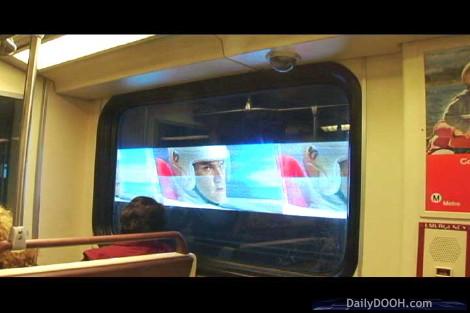Los Angeles Metro Does Tunnel Advertising
Adrian J Cotterill, Editor-in-Chief

Sidetrack Technologies are installing for free their electronic LED display in the Los Angeles County Metropolitan Transportation Authority (Metro) subway – the first such system in North America we believe.
It’s a two year pilot project that is expected to generate at least USD 240,000 per year in additional rail operating revenues for Metro. The 15?second advertisements will be visible to passengers on northbound trains between the Hollywood / Highland and Universal City stations.
The two parties have arranged an additional revenue sharing structure if revenues exceed certain benchmarks. The launch advertiser is the latest in a series of multiple “Bull’s Eye” images from US retailer Target. A ‘Speed Racer” commercial, shown above, was used for initial testing and we think you will agree looks great!
You may not have seen this technology in action, Sidetrack describe it;“the dark subway tunnels briefly turn trains into mobile movie theatres where passengers are dazzled by colorful, live?action video segments”.
Other Sidetrack installs currently include the London Heathrow Express, Singapore and Beijing.
Within the next two years, the Sidetrack expects to install systems in Boston, San Francisco, New York, Chicago and Washington.




January 19th, 2009 at 11:27 @518
do you know where I can get some images of the Villain/Hero billboard ads LA metro recently had running?
February 16th, 2009 at 11:20 @514
This type of innovative advertising technology appears to work well in America, as shown by the pilot test, and so would work well in other large cities around the world. Although it seems expensive it attracts wide audiences and keeps riders entertained.
Theories show consumers only pay attention to a small number of stimuli to which they are exposed, the stimuli they do pay attention to depends on their personal selection factors; such as perceptual vigilance, perceptual defence and adaptation. In other words riders tend to only pay attention when the product being advertised is of interest to them, they only see what they want to see and may ignore some adverts that make them feel negatively.
Stimulus selection factors such as colour, size, novelty and position all aid in the consumer paying more attention to an advert. The subway adverts capture attention using these four factors, for example, the dark tunnels are lit and riders are given something to watch whilst travelling. The advertisement shown is a perfect example of how marketers want their adverts to be shown and to be perceived by consumers.
Motion pictures enable riders to use more senses and so they become more stimulated towards the adverts. This is probably why the motion pictures are so successful and have been for sometime in other environments.
It’s important to keep adverts short and stimulating in order to prevent sensory overload. This can be done by perceptual positioning – the way the advertisements are positioned and perceived, for example, if too many adverts are positioned together it can lead to confusion and consumers are unable to recall adverts displayed. Sensory overload could lead to a potential burnout of this type of advertising, as consumers wouldn’t pay attention to adverts.
Compared to normal billboard adverts these adverts are eye catching, unavoidable and repetitive, which increases the chances of recall. The downfall of these adverts is the cost, time and disruption of mounting them and maintaining them, as commuters could be disrupted and have a negative view of the adverts.
June 26th, 2009 at 03:43 @196
I’d like to find out about the advertising inside the Red line and Purple and blue trains. Thank you